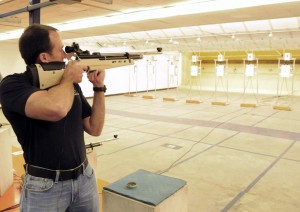
January 13, 2012 MSG Fernando Verones, Army Shooting Team Assistant Coach, demonstrates how to shoot the air rifle during the WTC shooting clinic held at the University of Texas, El Paso. Clinic participants are vying for a spot on the Army's Warrior Games 2012 shooting team. Photo Credit: SGT Valerie Lopez
By SGT Valerie Lopez, Headquarters 1st Armored Division
Inhale… exhale, the sound of breathing in a small quiet room, inhale…exhale, then a sudden pop as the pellet is shot from an air rifle into the target. The room is filled with Soldiers taking their shots at the tryouts for the 2012 Warrior Games Army shooting team.
25 wounded, ill, and injured Soldiers gathered from different installations at Fort Bliss and El Paso to participate in the Warrior Transition Command (WTC) shooting training clinic from January 11-14.
“This is our very first of three shooting clinics for selecting the 2012 Warrior Games Army shooting team,” said MSG Howard Day, Army shooting coach and student at United States Sergeants Major Academy (USASMA). “We partnered with University of Texas El Paso and Fort Bliss Warrior Transition Battalion (WTB, and representatives from Army Marksmanship Unit (USAMU) in order to make this clinic happen.”
The first Warrior Games was held in 2010, as an introduction to Paralympic sports for wounded, ill, and injured servicemembers and Veterans of all services: Army, Marine Corps, Navy, Air Force, Coast Guard, and Special Operations. During this year’s games, servicemembers and Veterans will compete in seven sports: archery, cycling, shooting, sitting volleyball, swimming, track and field, and wheelchair basketball.
This year the Army’s shooting training camp was held at the University of Texas, El Paso’s (UTEP) ROTC building. The participating Soldiers and Veterans lodged in the Fort Bliss WTB Barracks.
“This year’s mission is to bring home the gold from the Olympic Training Center in Colorado Springs, Colorado”, said Day.
During the clinic, the organizers setup three stations:-mental, physical, and range practice.
In the mental station, Lindsay Holtz, Performance Enhancement Specialist assisted shooters to create imagery scripts to do mental practice when they don’t have a weapon.
“It’s like a movie script that you play in your head to help you keep your patterns, muscles, and mind prepared for when you go back out there,” said Holtz.
UTEP women’s shooting coach George Brenzovich and student athlete Andrea Vautrin, exchanging ideas with the shooters on different ways to deal with anxieties and the pressures of competing. They also demonstrated alternate positions for shooting pertaining to each person’s disabilities or weaknesses.
The third station was an indoor air shooting range at the ROTC building where the participants practiced shooting and received instructions from coach Day, assistant coaches, and USASMA students MSG Fernando Verones, MSG Roger Lewis, and SGM Martin Barreras with the Army Marksmanship Unit (AMU).
“Despite their circumstances, these participants all come together to compete,” said Day.
One Soldier, SPC James Darlington, from the Walter Reed Army Medical Center WTB, at the young age of 19 was deployed with the 82nd Airborne when his group was hit with two rocket propelled grenades in July 2010, and his arm was struck. With nerve damage and muscle loss in his right arm, Darlington, now 21 years old, has his mom with him as his non-medical attendant.
“He did his job well,” said Gery Darlington, “because everyone came home from that deployment. He’s here alive, and we can deal with whatever happens with his arm.”
“The WTB has great programs to help Soldiers transition back to their units, and other activities to keep us from getting down,” said Darlington. “The shooting clinic helped us get better at shooting. I’m looking forward to getting on the team.”
The Soldiers’ injuries here run the full scope,” said Day, “from traumatic brain injury (TBI), to post-traumatic stress disorder (PTSD), to amputations. Many have multiple injuries and other medical conditions that challenge them.
SSG Tracy J. Smith, Alpha Company, CBWTU Georgia, Army National Guard with 48th Brigade, was deployed three times to Iraq and Afghanistan, survived mortar rounds, explosions, and firefights. Now battling TBI and PTSD, three pins in her knee and 50% hearing loss, Smith continues to stay active in everyday life.
“I was initially introduced to adaptive sports, and wanted to stay active and physically fit, so I did archery, seated shot put, track and field events, power lifting, and now marksmanship,” said Smith.
Smith said because of the TBI and the PTSD, she was at first nervous to handle a weapon, but after watching someone use the air rifle, it was not as “off-putting”. It was almost therapeutic.
“It’s almost a very easy reintroduction into the basics of Soldiering, but also very different from what we are taught in marksmanship,” said Smith. “I am doing this for those that can’t, for my battle buddy who is partly paralyzed and unable, because he would have if our situations were reversed.”
“Eighty-three Soldiers applied, and 75 were notified that they were eligible for these clinics,” said Day. “From these clinics, the best [shooters] will be put together to form our Army team.”
As a wounded Soldier himself, Day said it is vital for Soldiers to recognize that the injuries are not the end of their career and definitely not the end of possibilities in life.
“This is nothing but a speed bump, a simple turn in the road,” said Day. “There is a big bright future and lots of opportunities.”
For more information on the Warrior Games, visit http://usparalympics.org/military-and-veteran-programs/warrior-games-presented-by-deloitte


![WTC-Booth_FINAL_low-res-300x229[1]](https://webarchive.library.unt.edu/web/20130215211745im_/http://wtc.armylive.dodlive.mil/files/2010/06/WTC-Booth_FINAL_low-res-300x2291.jpg)



